tow AUDI A8 2016 Owner's Manual
[x] Cancel search | Manufacturer: AUDI, Model Year: 2016, Model line: A8, Model: AUDI A8 2016Pages: 302, PDF Size: 75.68 MB
Page 119 of 302
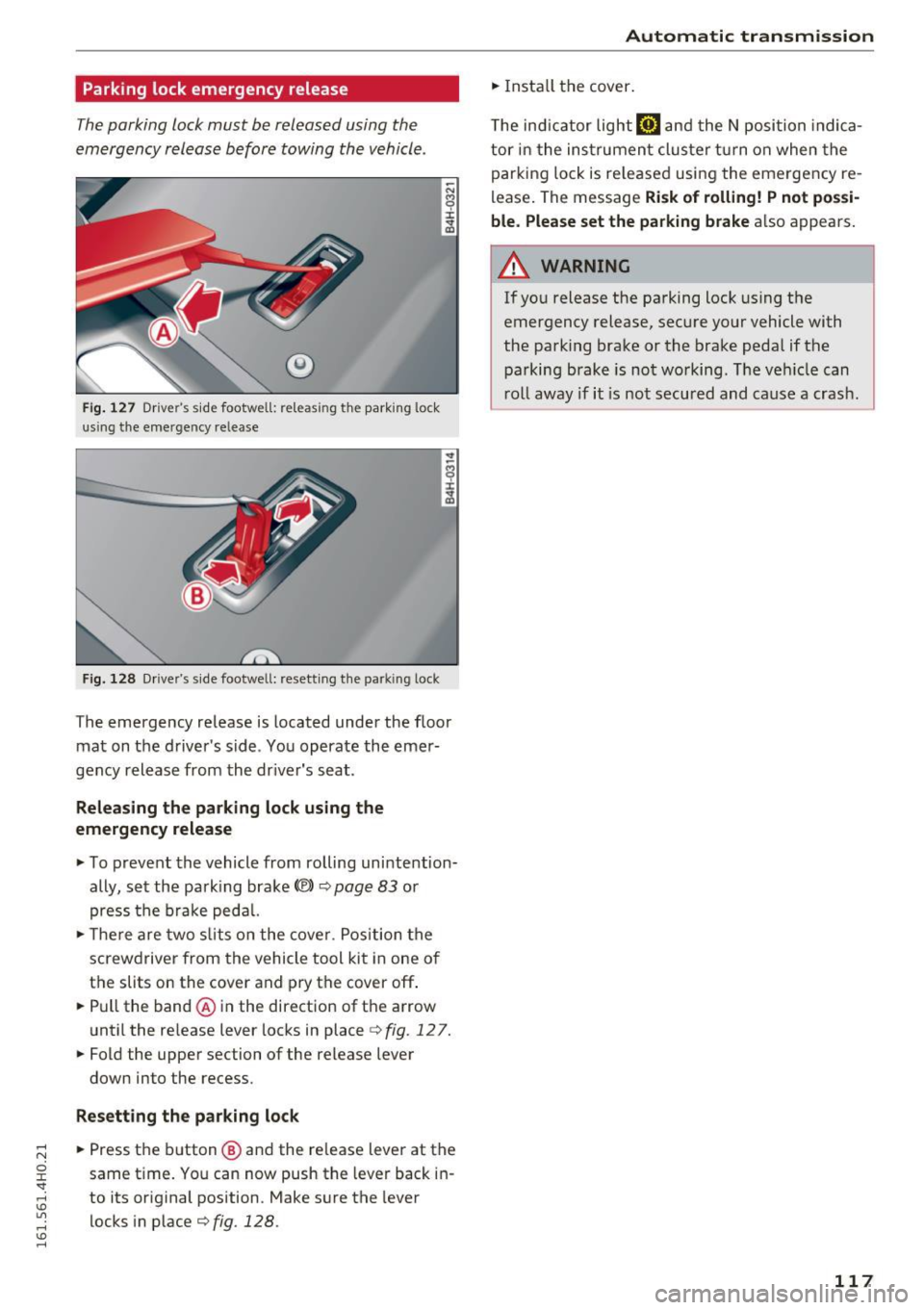
Parking lock emergency release
The parking lock must be released using the
emergency release before towing the vehicle .
®
Fig. 127 Dr iver's s ide footwell: releas ing the par king lock
us ing the eme rge ncy re lease
F ig . 128 D rive r's s ide foo twe ll: rese tt in g th e pa rking lock
The emergency release is located under the floor
ma t on t he d river's side . Yo u opera te the emer
gency release from the dr iver's seat .
Releasing the parking lock using the
emergency release
... To prevent the vehicle from rolling uni nte ntion
ally, set the pa rking brak e<®>
r=.> page 83 or
press the brake ped al.
... The re are tw o sli ts on t he cove r. Po sition the
s c rew driver from the vehicle tool kit i n one o f
the slits on the cover and pry the cover off .
... Pull the band@ in the direct ion of t he a rrow
unt il the re lease lever locks in place
r=.> fig . 127 .
... Fold the upper section of the release leve r
down into the recess.
Resetting the parking lock
... Press t he b utton @ and the re lease lever at the
same t ime . Yo u can now push the leve r back in
to its or iginal position . Make sure the lever
locks in p lace
<=.> fig. 128 .
Automatic transmission
... Insta ll the cover .
T he in dicator light@] and the N position indica
tor in the ins trument cluster t urn on when the
parki ng lo ck is re leased usi ng the eme rgency re
lease . The message
Risk of rolling! P not possi
ble. Please set the parking brake
a lso appears .
A WARNING
--
If you release the parking lock using the
emergency release, sec ure yo ur vehicle with
the parking brake or the brake peda l if the
p arking brake is not wo rking. The ve hicle can
r o ll away if i t is no t secured and cause a crash .
117
Page 120 of 302
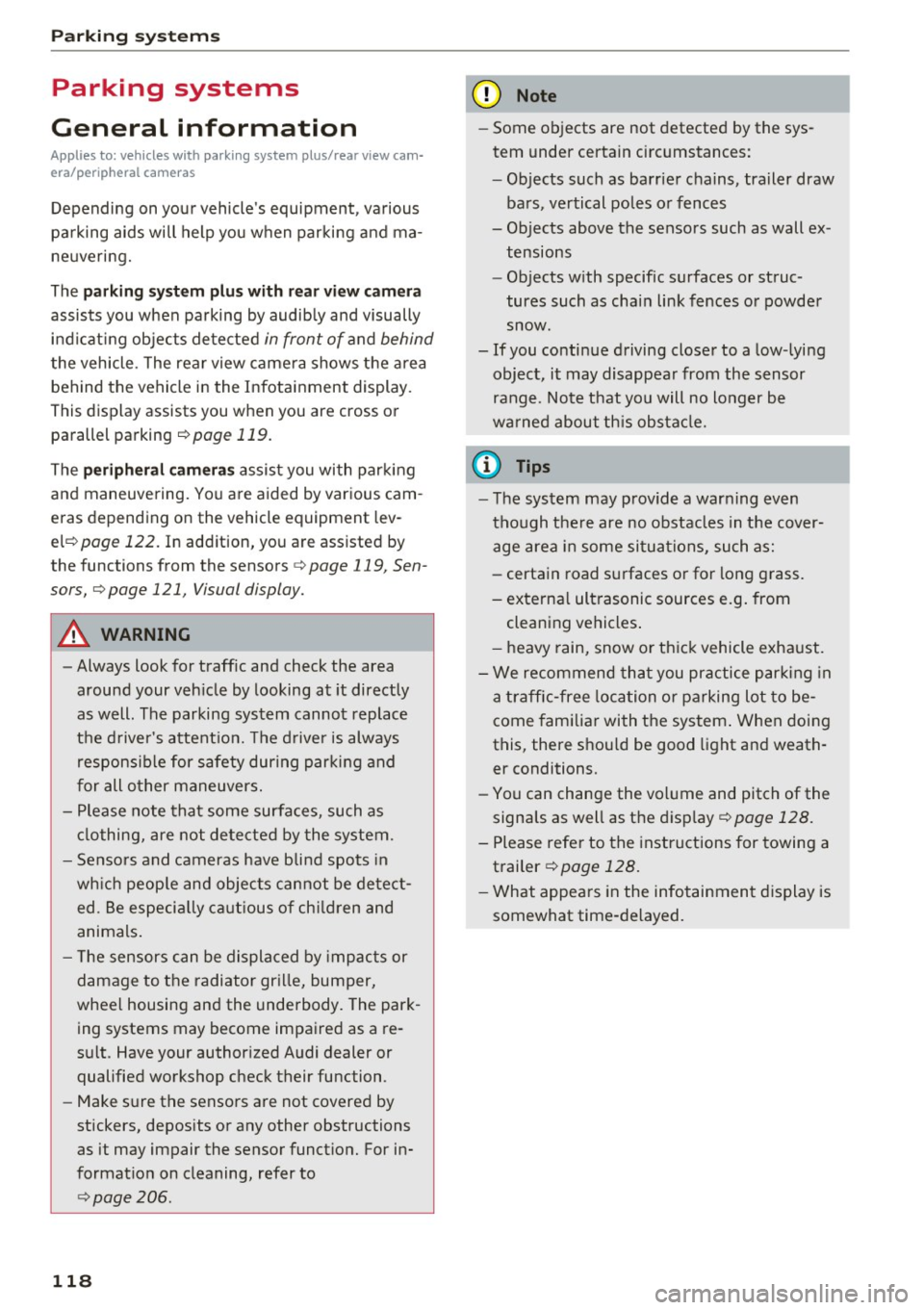
Parking systems
Parking systems
General information
Applies to: vehicles with park ing system plus/rear view cam
era/peripheral cameras
Depending on your vehicle 's equipment , various
parking aids will help you when parking and ma
neuvering.
The
parking system plus with rear view camera
assists you when parking by audibly and visually
indicating objects detected
in front of and behind
the vehicle . The rear view camera shows the area
behind the vehicle in the Infotainment display.
This display assists you when you are cross or parallel parking
r:!) page 119.
The peripheral cameras assist you with parking
and maneuvering. You are aided by various cam
eras depending on the vehicle equipment lev
el r:!)
page 122. In addition, you are assisted by
the functions from the sensors
c> page 119, Sen
sors,
¢ page 121, Visual display.
A WARNING
-
- Always look for traffic and check the area
around your vehicle by looking at it directly
as well. The parking system cannot replace
the driver's attention. The driver is always
responsible for safety during parking and
for all other maneuvers.
- Please note that some surfaces, such as
clothing, are not detected by the system.
- Sensors and cameras have b lind spots in
wh ich peop le and objects cannot be detect
ed . Be especially cautious of children and
animals.
- The sensors can be displaced by impacts or
damage to the radiator gr ille, bumper,
wheel housing and the underbody. The park
ing systems may become impaired as a re
sult. Have your authorized Audi dealer or
qualified workshop check their function .
- Make sure the sensors are not covered by
stickers, deposits or any other obstructions as it may impair the sensor function. For in
formation on cleaning, refer to
I:!) page 206.
118
(D Note
- Some objects are not detected by the sys
tem under certain circumstances:
-Objects such as barrier chains, trailer draw
bars, vertical poles or fences
- Objects above the sensors such as wall ex
tensions
- Objects with specific surfaces or struc
tures such as chain link fences or powder
snow.
- If you continue driving closer to a low-lying
object, it may disappear from the sensor
range. Note that you will no longer be
warned about this obstacle.
(D Tips
-The system may provide a warning even
though there are no obstacles in the cover
age area in some situations, such as:
- certain road surfaces or for long grass.
- externa l ultrasonic sources e.g. from
cleaning vehicles .
- heavy rain, snow or thick vehicle exhaust .
- We recommend that you practice parking in
a traffic-free location or parking lot to be
come familiar with the system . When doing
this, there should be good light and weath
er conditions.
- You can change the volume and pitch of the
signals as well as the display¢
page 128.
- Please refer to the instructions for towing a
trailer
¢page 128.
-What appears in the infotainment display is
somewhat time-delayed.
Page 122 of 302

Parking system s
If the distance to an obstacle r emains constant,
the volume of the distance warn ing gradually
drops after about four seconds (th is does not ap
ply in the continuous tone range) .
Rear vie w cam era
The rea r view camera is located above the rear li
cense plate bracket. Make sure that the lens for
the park ing system
¢ fig . 132 is not covered by
deposits or any other obst ructions because this
can affe ct the function of the parking system . For
information on clean ing, refer to¢
page 206.
The rear view camera coverage area includes@
¢fig. 131 . Only this a rea is shown in the Info
tainment display. Objects that are outside of th is
area @are not displayed.
The accuracy of the orientation lines and the blue
surfaces is reduced if the adaptive air suspen
sion " is faulty, if the vehicle is lifted or if the
dy
n amic
mode is activated ¢ page 106 .
A WARNING
-Always read and follow the applicable warn
ings
¢ .& in General information on
page 118 .
-If the posit io n and the installation angle of
the rear view camera was changed , for ex
ample, after a co llision, do not continue to
use the system for safety reasons . Have i t
checked by your author ized Audi dealers hip
or authorized repair faci lity .
- Only use the rear view came ra to assist you
if it shows a good, clear picture . For exam
ple, the image may be affected by the sun
shining into the lens, dirt on the lens or if
there is a system fau lt .
- Use the rear view camera only if the l uggage
compartment lid is completely closed. Make
sure any objects you may have mounted on
the luggage compartment lid do not block
the rear view camera.
- The camera lens enlarges and distorts the
field of vis ion. T he object appears both al
tered and inaccurate on the screen .
- In certain situations, people or objects in
the d isplay appear closer or further away :
120
-objects that do not to uch the ground, such
as the bumper of a parked vehicle , a tra iler
hitch or the rear of a truck. Do not use the
help lines in this case.
- If driven from a level surface onto an in
cline, or a downward slope .
- If driven toward protruding objects.
-If the vehicle is carrying too much load in
the rear.
(D Note
- Always read and fo llow the applicable wa rn
ings
¢ (i) in General information on
page 118 .
-The orange co lored orientation lines in the
Infota inment display show the vehicle path
depending on the steer ing whee l ang le . The
front of the vehicle front swings out more
than the rear of the vehicle. Maintain plenty of distance so that your outside mirror or a
corner of your vehicle does not collide w ith
any obstacles .
Switching on /off
Applies to: vehicles with parking system plus with rear view
camera
F ig . 133 Center co n sole : Pa rk ing syste m swi tch
Switching on
... Shift into reverse or
... press the
p,q ~ button in the center conso le
¢ fig. 133. A short confirmation tone so unds
and the LED in the b utton turns on.
Switching b etween the rear view camera and
optica l d isplay
... Press the Graphic cont rol button ©
¢page 121, fig. 134 to see the optical d isplay . ..,.
Page 129 of 302

to this vehicle should be approximately 3 ft
(1 m).
.. Turn the Infotainment on and shift into reverse
gear. The parking system is turned on and the
cross parking indicator is displayed .
.. Press the
(D Q page 122, fig . 136 control but
ton on the Infotainment un it repeatedly until
the
parallel parking v iew is displayed .
.. Back up and align yo ur vehicle so the blue area
@ borders on the rear end of the vehicle or on
the parking space line
Q .&. in General infor
mation on page 123,
Q (D in General informa
tion on page 123 .
The blue area represents an
extension of the veh icle's outline by approxi
mately
16 ft (5 m) to the rear. The long side of
the blue area should be on the curb. The entire
blue area must fit into the parking space .
.. With the ve hicle stopped, turn the steer ing
wheel to the right as far as it will go .
.. Back into the park ing space until the b lue curve
Q page 122, fig . 13 7 tou ches the curb Q .&. in
General information on pag e 123,
Q (D in Gen
eral information on page 123 .
Stop the vehicle .
.. With the vehicle stopped, tu rn the steering
whee l to the left as far as it will go .
.. Cont inue to back into the parking space unt il
the vehicle is parked parallel to the curb
Q .&.
in General information on page 123, Q (D in
General information on page 123.@
marks
the rear bumper. Stop the vehicle, at the latest,
when the red or ien tat ion line @ borders a n ob
ject. Keep an eye on the front of your ve hicle
wh ile doing this.
Parking next to obstacles
When there is an obstacle (such as a wal l) next to
the parking space, choose a space w ith more
space on the sides. Posit ion the long side of the
b lue area so that there is sufficient space from
the obstacle . The a rea must not be o n the obsta
cle. You wi ll also need to start turning the steer
ing wheel much earlie r. T here shou ld be a suffi
cient amount of space between the obstacle and
the blue curve, and the b lue curve
Q page 122,
fig . 13
7 must not touch the obstacle .
Parking systems
(D Tips
The left or right orientation lines and surfaces
will be d isp layed, depend ing on the turn sig
nal be ing used.
Trailer view
Appl ies to : veh icles w ith top view camera system and trailer
h itch
This view assists you in p ositioning the vehicle in
fron t of a trailer.
Fig . 1 50 Infota in m ent : rea r mode
R equirement: the trailer mode is selected
Q page 125 .
.. Now you can position your veh icle in front o f
the t railer
Q .&. in General information on
page 123,
Q (y in General information on
page 123.
The orange colored orientation l ine
denotes the expected path toward the trailer h itch . Use the blue li nes to help you est imate
the distance to the tra iler hitch.
Setting the mode
Applies to: veh icles w ith top view camera system
.., Select: !CAR ! function button> Car sy stem s
cont rol b utton > Dri ver a ssi st > Parking aid >
Change to front /rear > Auto or Manual.
Auto -
This view behind the vehicle ( Rear mode)
is d isp layed a utomat ica lly when you shift into re
verse. This view i n fron t of the vehicle
(Front
mode) is d isp layed automat ica lly when you shift
i nto the forward gea rs.
Manual -This view beh ind the veh icle (Rear
mode) is a lways displayed when you t urn on the
system .
127
Page 130 of 302
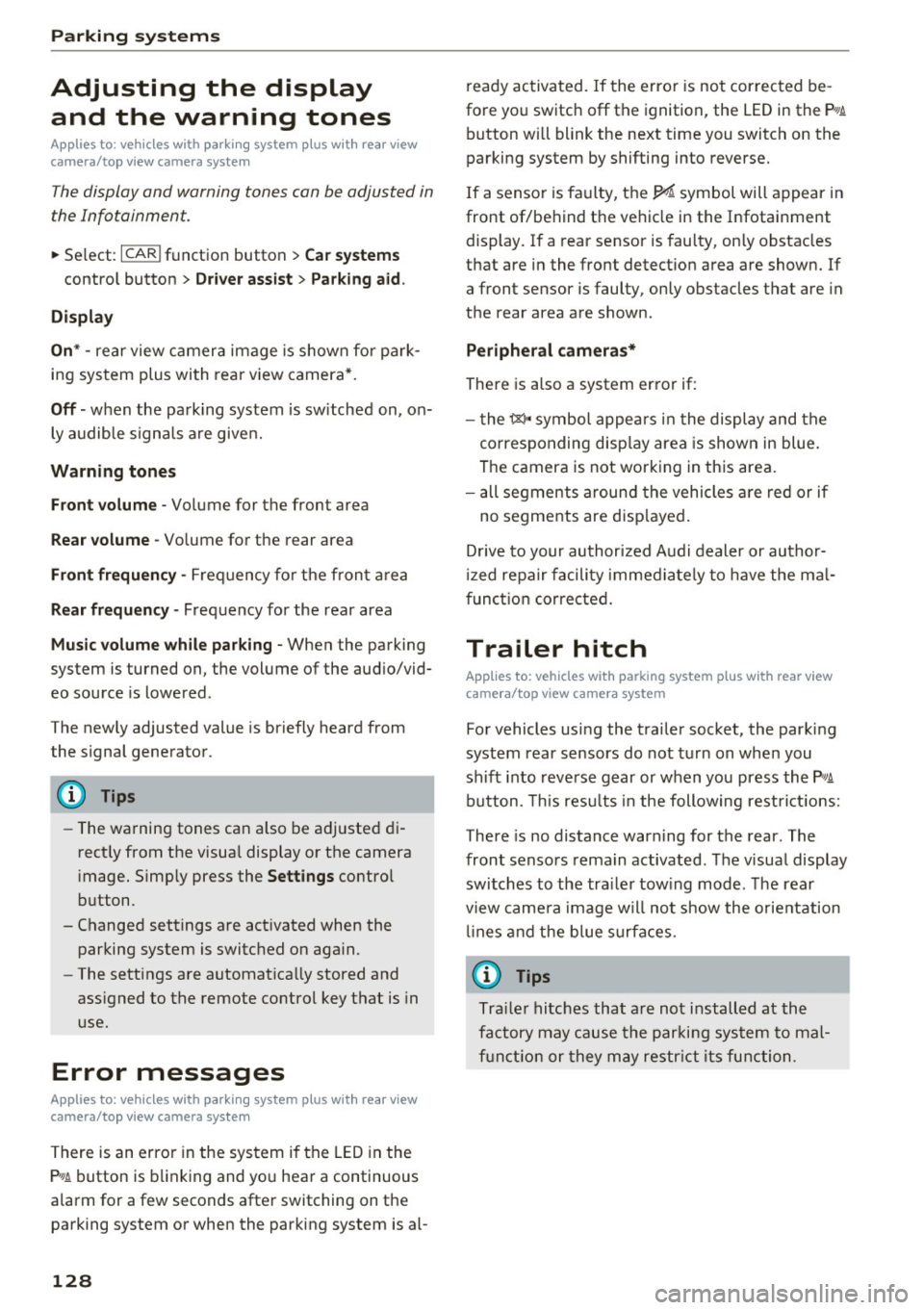
Parking systems
Adjusting the display
and the warning tones
Applies to: ve hicles with parking system plus wit h rea r view
camera/top v iew camera system
The display and warning tones con be adjusted in
the Infotainment.
~ Se lect: ICARI function button> Car systems
contro l button > Driver assist > Parking aid.
Display
On* -
rear view camera image is shown for park
ing system plus with rear view camera*.
Off -when the parking system is sw itched on, on
ly audible signals are given.
Warning tones
Front volume -
Volume for the front area
Rear volume -Volume for the rear area
Front frequency -Frequency for the fron t area
Rear frequency -Frequency for the rear area
Music volume while parking -When the parking
system is turned on, the volume of the aud io/vid
eo source is lowered .
The newly adjusted value is briefly heard from
the signal generator.
(D Tips
- The warning tones can also be adjusted di
rectly from the visua l display or the camera
i mage. Simp ly press the
Settings contro l
button .
- Changed settings are act ivated when the
parking system is switched on aga in.
- The settings are automat ically stored and
ass igned to the remote control key that is in
use.
Error messages
Applies to: veh icles w ith parking system plus with rear view
camera/top v iew camera system
There is an error in the system if the LED in the
P, YA button is blinking and you hear a continuous
a larm for a few seconds after switching on the
parking system or when the parking system is al-
128
ready activated. If the error is not corrected be
fore you switch off the ignition, the LED in the
Po/A
button will blink the next time you switch on the
parking system by shifting into reverse.
If a sensor is faulty, the~ symbol will appear in
front of/behind the vehicle in the Infotainment display. If a rear sensor is faulty, only obstacles
that are in the front detect ion area are shown. If
a front sensor is faulty , only obstacles that are in
the rear area are shown .
Peripheral cameras*
There is also a system error if :
- the~" symbol appears in the display and the
corresponding display area is shown in blue.
The camera is not working in this area.
- all segments around the vehicles are red or if
no segments are disp layed.
D rive to your authorized Aud i dealer or author
iz ed repair facility immediately to have the mal
function corrected.
Trailer hitch
Applies to: vehicles with parking system plus with rear view
camera/top view camera system
For vehicles using the trailer socket, the parking
system rear sensors do not turn on when you
shift into reverse gear or when you press the
P,YA
button. This resu lts in the following restrictions:
There is no distance warning for the rear. The
front sensors remain activated . Th e visual display
switches to the tra iler tow ing mode . The rear
view camera image will not show the orientation
lin es and the blue surfaces.
(D Tips
Trailer hitches that are not installed at the
factory may cause the parking system to mal
function or they may restrict its function .
Page 133 of 302
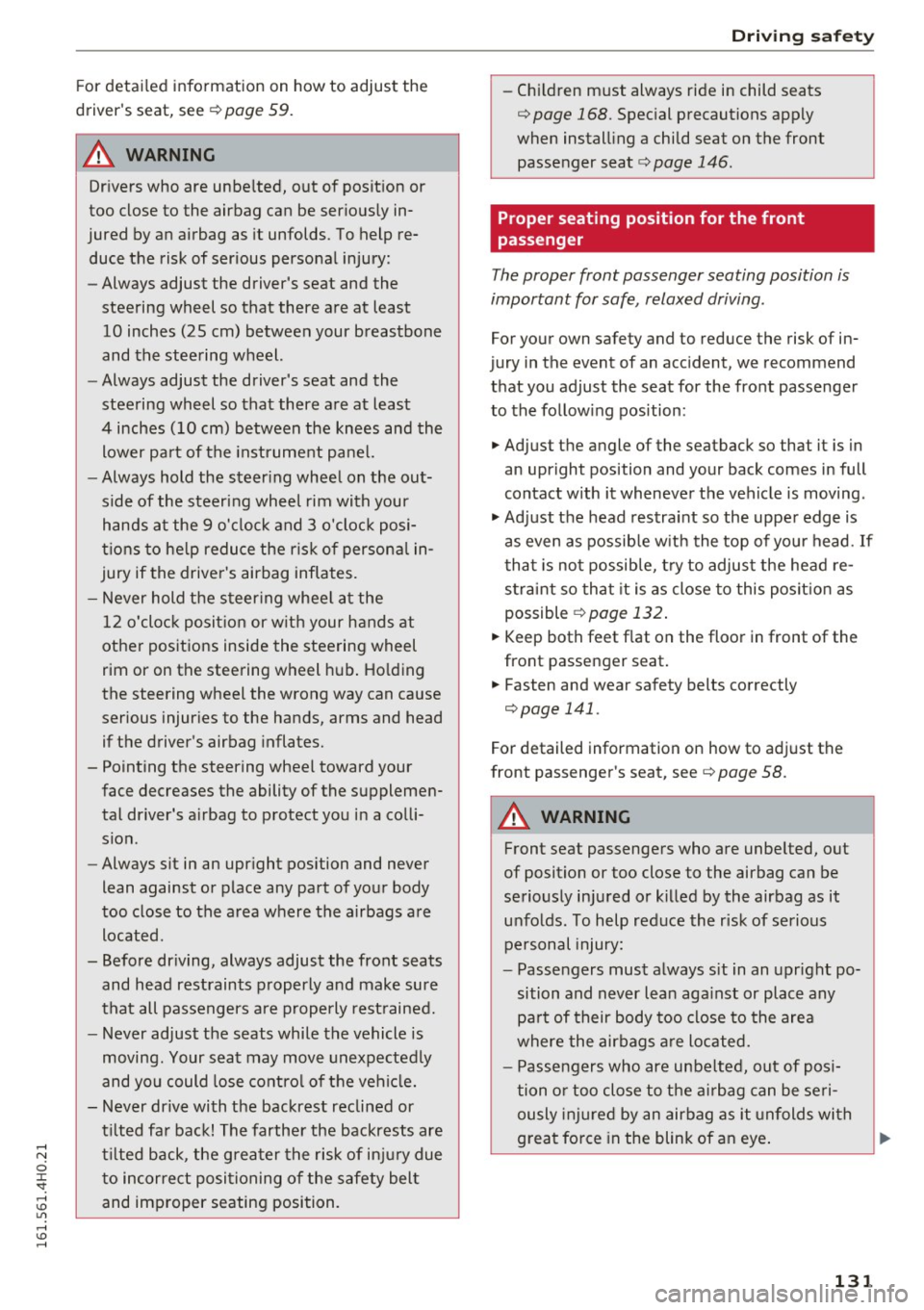
For detailed information on how to adjust the
driver's seat, see
¢ page 59.
A WARNING
Drivers who are unbelted, out of position or
too close to the airbag can be seriously in
jured by an airbag as it unfolds. To help re
duce the risk of serious personal injury:
- Always adjust the driver's seat and the
steering wheel so that there are at least 10 inches (25 cm) between your breastbone
and the steering wheel.
- Always adjust the driver's seat and the
steering wheel so that there are at least
4 inches (10 cm) between the knees and the
lower part of the instrument panel.
- Always hold the steering wheel on the out
side of the steering wheel rim with your
hands at the 9 o'clock and 3 o'clock posi
tions to help reduce the risk of personal in
jury if the driver's airbag inflates.
- Never hold the steering wheel at the
12 o 'clock position or with your hands at
other positions inside the steering wheel
rim or on the steering wheel hub. Holding
the steering wheel the wrong way can cause
serious injuries to the hands, arms and head if the driver's airbag inflates.
- Pointing the steering wheel toward your face decreases the ability of the supplemen
tal driver's airbag to protect you in a colli
sion.
- Always sit in an upright position and never
lean against or place any part of your body
too close to the area where the airbags are
located.
- Before driving, always adjust the front seats and head restraints properly and make sure
that all passengers are properly restrained.
- Never adjust the seats while the vehicle is
moving . Your seat may move unexpectedly
and you could lose control of the vehicle.
- Never drive with the backrest reclined or
tilted far back! The farther the backrests are
tilted back, the greater the risk of injury due
to incorrect positioning of the safety belt
and improper seating position.
Driving safety
- Children must always ride in child seats
¢
page 168. Special precautions apply
when installing a child seat on the front passenger seat¢
page 146.
Proper seating position for the front
passenger
T he proper front passenger seating position is
important for safe, relaxed driving .
For your own safety and to reduce the risk of in
jury in the event of an accident, we recommend
that you adjust the seat for the front passenger
to the following position :
... Adjust the angle of the seatback so that it is in
an upright position and your back comes in full
contact with it whenever the vehicle is moving.
... Adjust the head restraint so the upper edge is
as even as possible with the top of your head.
If
that is not possible, try to adjust the head re
straint so that it is as close to this position as
possible
¢ page 132.
... Keep both feet flat on the floor in front of the
front passenger seat.
... Fasten and wear safety belts correctly
¢page 141.
For detailed information on how to adjust the
front passenger's seat, see¢
page 58.
A WARNING
-Front seat passengers who are unbelted, out
of position or too close to the airbag can be
seriously injured or killed by the airbag as it
unfolds . To help reduce the risk of serious
personal injury:
- Passengers must always sit in an upright po
sition and never lean against or place any part of their body too close to the area
where the airbags are located.
- Passengers who are unbelted, out of posi
tion or too close to the airbag can be seri
ously injured by an airbag as it unfolds with
great force in the blink of an eye . ..,
131
Page 137 of 302
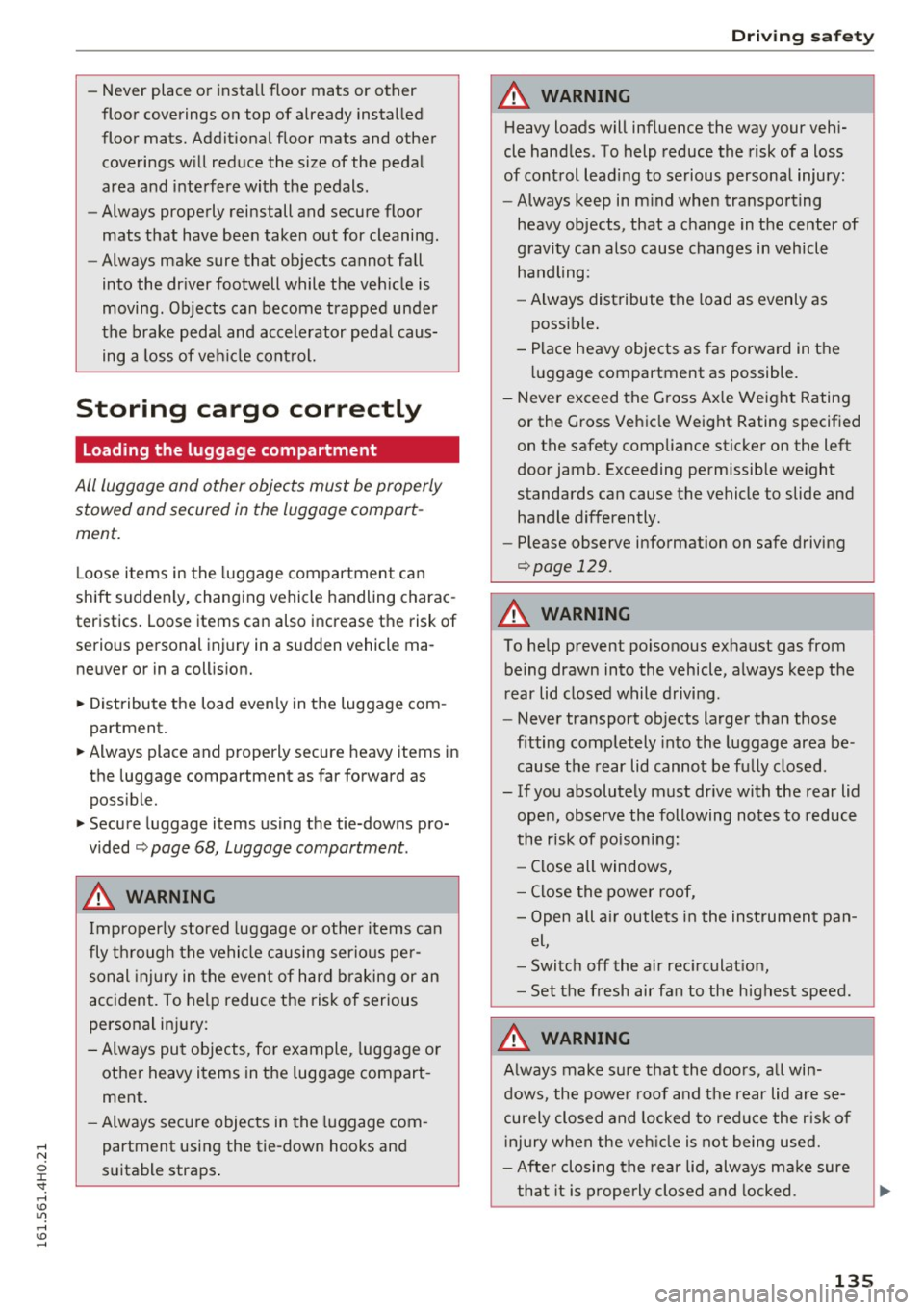
-Never place or install floor mats or other
floor coverings on top of already installed
floor mats. Additional floor mats and other
coverings will reduce the size of the pedal
area and interfere with the pedals .
- Always properly reinstall and secure floor
mats that have been taken out for cleaning.
- Always make sure that objects cannot fall
into the driver footwell while the vehicle is
moving . Objects can become trapped under
the brake pedal and accelerator pedal caus ing a loss of veh icle control.
Storing cargo correctly
Loading the luggage compartment
All luggage and other objects must be properly
stowed and secured in the luggage compart
ment.
L oose items in the luggage compartment can
shift suddenly, changing vehicle handling charac
teristics. Loose items can also increase the risk of
serious personal injury in a sudden vehicle ma
neuver or in a collision.
.. Distribute the load evenly in the luggage com
partment.
.. Always place and properly secure heavy items in
the luggage compartment as far forward as
possible.
.,. Secure luggage items using the tie-downs pro
vided
¢ page 68, Luggage compartment .
A WARNING
Improperly stored luggage or other items can
fly through the vehicle causing serious per
sonal injury in the event of hard braking or an
accident. To help reduce the risk of serious
personal injury:
- Always put objects, for example, luggage or
other heavy items in the luggage compart
ment.
- Always secure objects in the luggage com
partment using the tie-down hooks and
suitable straps .
Driving safety
A WARNING
Heavy loads will influence the way your vehi
cle handles. To help reduce the risk of a loss
of control lead ing to serious personal injury:
- Always keep in m ind when transporting
heavy objects, that a change in the center of
gravity can also cause changes in vehicle handling:
- Always distribute the load as evenly as
possible .
- Place heavy objects as far forward in the
luggage compartment as possible.
- Never exceed the Gross Axle Weight Rating
or the Gross Vehicle Weight Rating specified
on the safety compliance sticker on the left
door jamb. Exceeding permissible weight
standards can cause the vehicle to slide and handle differently.
- Please observe information on safe driving
¢page 129.
A WARNING
To help prevent poisonous exhaust gas from
being drawn into the vehicle, always keep the
rear lid closed while driving .
- Never transport objects larger than those
f itting completely into the luggage area be
cause the rear lid cannot be fully closed.
- If you absolutely must drive with the rear lid open, observe the following notes to reduce
the risk of poisoning:
- Close all windows,
- Close the power roof,
- Open all air outlets in the instrument pan-
el,
- Switch off the air recirculation
,
- Set the fresh air fan to the highest speed .
A WARNING
Always make sure that the doors, all win
dows, the power roof and the rear lid are se
curely closed and locked to reduce the r isk of
in jury when the vehicle is not being used.
- After closing the rear lid, always make sure
that it is properly closed and locked.
-
135
Page 145 of 302
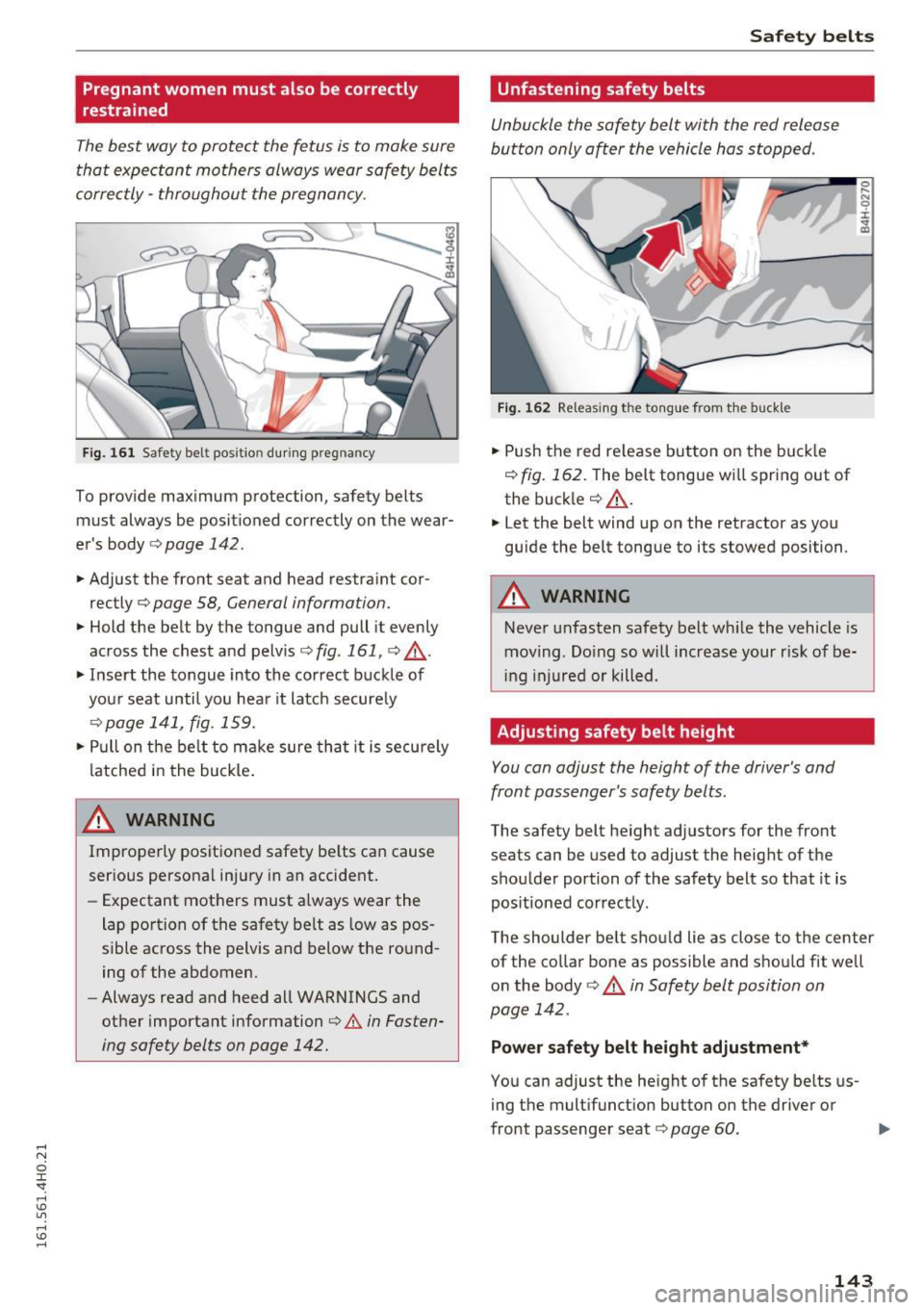
Pregnant women must also be correctly
restrained
The best way to protect the fetus is to make sure
that expectant mothers always wear safety belts
corre ctly -throughout the pregnan cy.
F ig. 161 Safety belt pos itio n dur ing pregnancy
To provide max imum protection, safety belts
must always be posit ioned correctly on the wear
er 's body
¢ page 142.
.,. Adjust the front seat and head restraint cor
rectly
c> page 58, General information .
.,. Hold the belt by the tongue and pull it evenly
across the chest and pelvis
c> fig. 161, c> ,&. .
.,. Insert the tongue into the correct buckle of
your seat until you hea r it latch secure ly
c> page 141, fig . 159.
.,. Pull on the be lt to ma ke sure that it is securely
latched in the buckle .
A WARNING
Improperly positioned safety be lts can cause
serious personal inju ry in an accident.
- Expectant mothers must a lways wear the
lap po rtion of the safety belt as low as pos
sible across the pelvis and below the round
ing of the abdomen .
- Always read and heed all WARNINGS and
other important information
¢ .&. in Fasten
ing safety belts on page 142.
Safet y bel ts
Unfastening safety belts
Unbuckle the safety belt with the red release
button only o~er the vehicle hos stopped .
J-L
Fig . 1 62 Re leasing t he tong ue from the buckle
.. Push the red re lease button on the buck le
¢ fig . 162. The belt tongue w ill spring out of
the buck le¢ ,&..
.,. Let the belt wind up on the retractor as you
guide the belt tongue to its stowed position .
_& WARNING ,-
Never unfasten safety belt wh ile the vehicle is
moving . Do ing so will increase your r isk of be
in g injured or killed .
Adjusting safety belt height
You con adjust the height of the driver's and
front passenger's safety belts .
The safety belt height adjusters for the front
seats can be used to adjust the height of the
shoulder portion of the safety belt so that it is
pos itioned correctly .
0 ..... N
0
:i:
"' CD
The shoulder belt shou ld lie as close to the center
of the collar bone as possible and s hou ld fit well
on the body
¢ .&. in Safety belt position on
page 142 .
Power safety belt height adjustment*
You can adjust the he ight of the safety be lts us
ing the multifunction button on the driver or
front passenger seat¢
page 60 .
143
Page 156 of 302
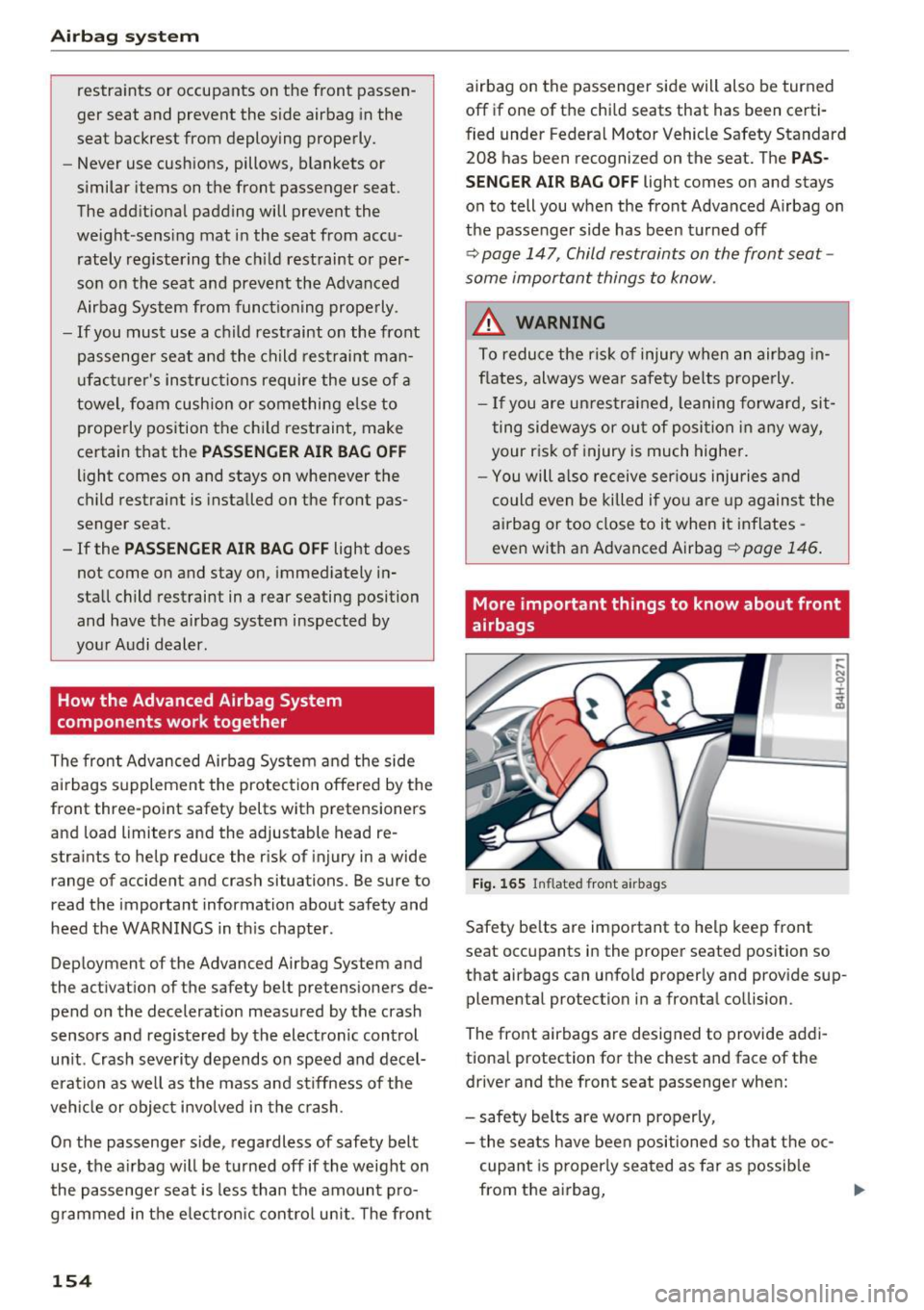
Airbag syste m
restraints or occupants on the front passen
ger seat and prevent the side airbag in the
seat backrest from deploying properly.
- Never use cushions, pillows, blankets or
similar items on the front passenger seat.
The additional padding will prevent the
weight-sens ing mat in the seat from accu
rately reg istering the ch ild restraint or per
son on the seat and prevent the Advanced
Airbag System from funct ioning prope rly.
- If you must use a child restraint on the front
passenge r seat and the child restraint man
ufact urer's instructions require the use of a
towel, foam cushion or something else to properly position the chi ld restraint, make
certain that the
PASSENGER AIR BAG O FF
light comes on and stays on whenever the
child restraint is installed on the front pas
senger seat.
- If the
PASSENGER AIR BAG O FF light does
not come on and stay on, immediately in
stall child restrai nt in a rear seating position
and have the airbag system inspected by
you r Audi dealer.
How the Advanced Airbag System
components work together
The front Advanced Airbag System and the side
ai rbags supplement the protection offered by the
front three-point safety belts with pretensioners and load limiters and the adjustable head re
stra ints to help reduce the r isk of injury in a wide
range of accident and crash situations. Be sure to
read the important information about safety and heed the WARNINGS in th is chapter .
Deployment of the Advanced Airbag System and
the activation of the safety belt pretensioners de pend on the deceleration measured by the crash
sensors and registered by the electronic control
unit . Crash severity depends on speed and decel
era tion as we ll as the mass and stiffness of the
vehicle or object invo lved in the crash.
On the passenger s ide, regardless of safety belt
use, the a irbag will be t urned off if the weight on
the passenge r seat is less than the amount p ro
g rammed in the e lectron ic cont rol unit . T he front
154
airbag on the passenger side will also be turned
off if one of the chi ld seats that has been certi
fied under Federal Motor Vehicle Safety Standard 208 has been recognized on the seat. The
PA S
S EN GER AIR BA G OFF
light comes on and stays
on to tell you when the front Advanced A irbag on
the passenger side has been turned off
¢ page 147, Child restraints on the front seat
some important things to know .
.&_ WARNING
To reduce the risk of injury when an airbag in
f lates, always wear safety belts properly.
- I f you are unrestrained, leaning forward, sit
ting sideways or ou t of position in any way,
your ris k of injury is much highe r.
- You will a lso receive ser ious injuries and
could even be killed if yo u are up against the
airbag or too close to i t when it inflates -
even with an Advanced Airbag
r::!;>page 146.
More important things to know about front
airbags
Fig. 165 Inflated front a irbags
-,... N 0 :i: ;;i;
Safety be lts are important to help keep front
seat occupants in the proper seated position so
that airbags can unfo ld properly and prov ide sup
plemental protection in a fronta l co llision.
The front airbags a re designed to provide addi
tional protection for the chest and face of the driver and the front seat passenger when:
- safety belts are worn properly,
- t he seats have been positioned so that t he oc-
cupant is properly seated as far as possib le
from the airbag,
Ill-
Page 182 of 302
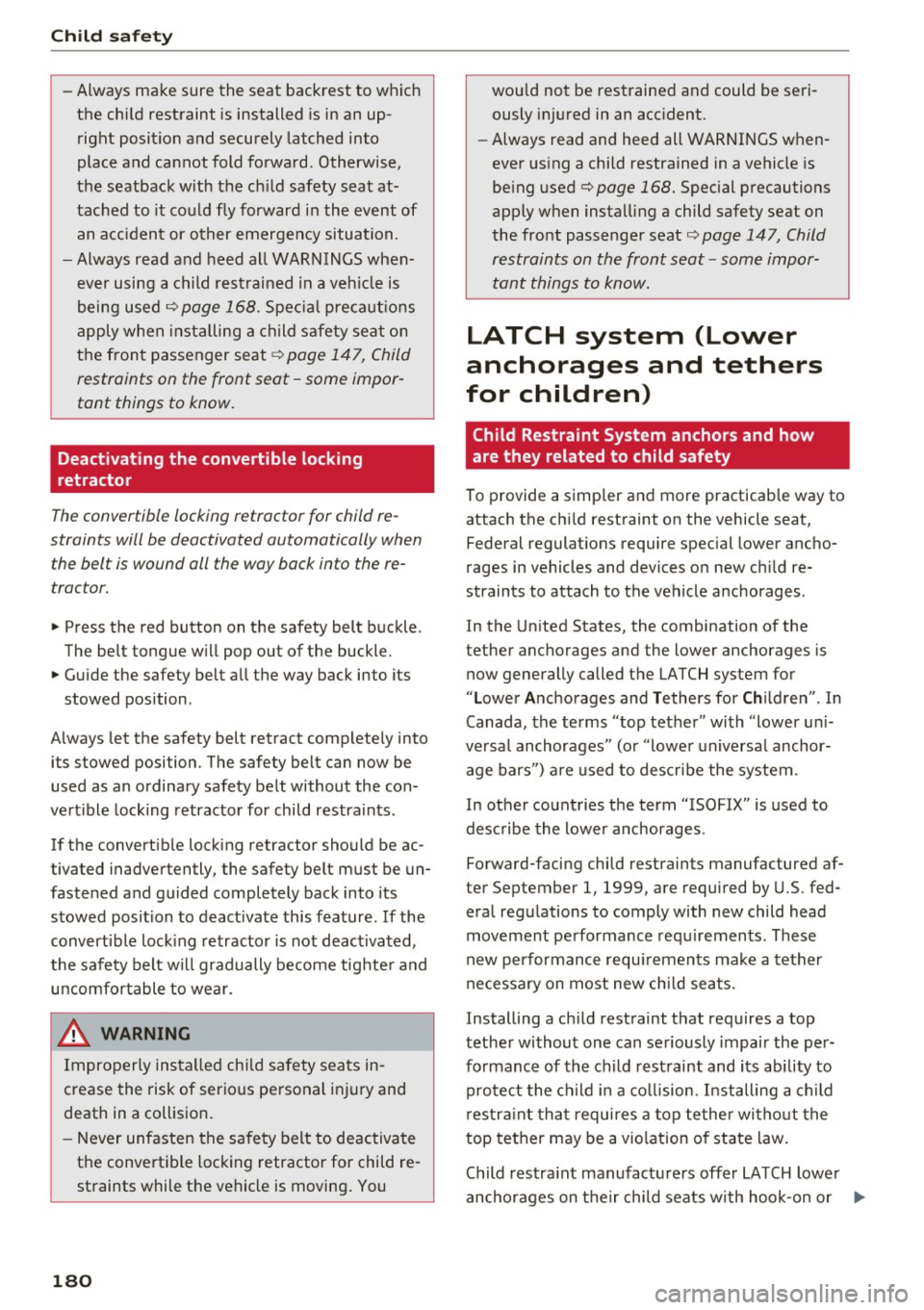
Child safety
-Always make sure the seat backrest to which
the child restraint is installed is in an up
right position and securely latched into
place and cannot fold forward. Otherwise,
the seatback with the child safety seat at
tached to it could fly forward in the event of
an accident or other emergency situation.
- Always read and heed all WARNINGS when
ever using a child restrained in a vehicle is
being used
c:::> page 168 . Special precautions
apply when installing a child safety seat on
the front passenger seat¢
page 147, Child
restraints on the front seat -some impor
tant things to know.
Deactivating the convertible locking
retractor
The convertible Locking retractor for child re
straints will be deactivated automatically when
the belt is wound all the way bock into the re
tractor .
~ Press the red button on the safety belt buckle.
Th@ belt tongue will pop out of the buckle.
~ Guide the safety belt all the way back into its
stowed position .
Always let the safety belt retract completely into
its stowed position . The safety belt can now be
used as an ordinary safety belt without the con
vertible locking retractor for child restraints .
If the convertible locking retractor should be ac
tivated inadvertently, the safety belt must be un
fastened and guided completely back into its
stowed position to deactivate this feature. If the
convertible lock ing retractor is not deactivated,
the safety belt will gradually become tighter and
uncomfortable to wear.
A WARNING
-
Improperly installed child safety seats in
crease the risk of serious personal injury and
death in a collision.
- Never unfasten the safety belt to deactivate
the convertible locking retractor for child re straints while the vehicle is moving . You
180
would not be restrained and could be seri
ously injured in an accident.
- Always read and heed all WARNINGS when
ever using a child restrained in a vehicle is
being used
¢page 168. Special precautions
apply when installing a child safety seat on
the front passenger seat
c:::> page 147, Child
restraints on the front seat -some impor
tant things to know.
LATCH system (Lower
anchorages and tethers
for children)
' Child Restraint System anchors and how
are they related to child safety
To provide a simpler and more practicable way to
attach the child restraint on the vehicle seat, Federal regulations require special lower ancho
rages in vehicles and devices on new child re
straints to attach to the vehicle anchorages .
In the United States, the combination of the
tether anchorages and the lower anchorages is
now generally called the LATCH system for
"Lower Anchorages and Tethers for Children" . In
Canada, the terms "top tether" with "lower uni
versal anchorages" (or "lower universal anchor
age bars") are used to describe the system .
In other countries the term "ISOFIX" is used to
describe the lower anchorages .
Forward-facing child restraints manufactured af
ter September 1, 1999, are required by U.S. fed
eral regulations to comply with new child head
movement performance requirements . These
new performance requirements make a tether
necessary on most new child seats.
Installing a child restraint that requires a top
tether without one can seriously impair the per
formance of the child restraint and its ab ility to
protect the child in a collision. Installing a child
restraint that requires a top tether without the
top tether may be a violation of state law.
Child restraint manufacturers offer LATCH lower
anchorages on their child seats with hook-on or ...